Part 3 will discuss Meandrinids, Mussids, Oculiniids, Caryophillidae, Hydrocorals, and others corals.

Tall upright columns of Dendrogyra cylindricus have long polyps which give the surface a fuzzy appearance.
Meandrinids
Dendrogyra cylindricus is arguably one of the most majestic Carribean corals after Acropora palmata. The colonies form very tall, tightly packed upright pillars which may reach six to eight feet in height and almost as wide at the base. The corallites are meandering, long and continuous and they bare fuzzy golden brown polyps which are extended throughout the day. The species doesn’t occur in any great abundance but it is very recognizable and hard to confuse with any other species.
Dichocoenia stokesi is the species of Meandrinids with the smallest corallites. At first glance it closely resembles Faviid species but it is differentiated by the strongly exert corallites with two cycles of prominent septa. Dichocoenia colonies are massive, encrusting or plating in colors of dark to light brown or golden yellow. Colonies are most commonly found at intermediate depths, rarely in shallow water where it tends to be very pale in color. D. stokesi is the only recognized species with two general forms. The nominal ‘stokesi’ form has uniform, small round or oval corallites with only one mouth. The secondary ‘stellaris’ form has more strongly exert, elongated corallites which sometimes have more than one mouth per polyp.
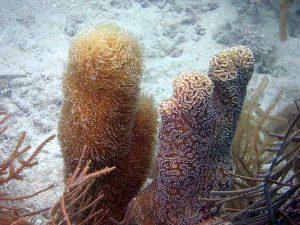
Dendrogyra cylindricus with polyps extended on the left column and the polyps retracted on the right column.
Meandrina is a group of stony coral with an uncertain taxonomy. The genus contains at least one true species with four recognized forms, one of which was formerly considered a separate genus altogether. The yellow to brown surface is characterized by deep valleys and strong ridges made up of long, thin, plate-like septa. Meandrina colonies are usually between one to three feet across and they occur from shallow to deep reef environments, being most common at intermediate depths. M. meandrites occurs as plating, encrusting or submassive colonies. The ‘danai’ form occurs in deeper water as a smallish, stalked colony. The ‘brasiliensis’ form is also stalked and it can be found attached or free living in calm sandy substrates where it doesn’t reach more than a few inches across. Meandrina ‘brasiliensis’ colonies have an elongated appearance with a long central groove surrounded by a convoluted outer edge. Meandrina ‘memorialis’ departs from the typical Meandrina shape by growing into columns which somewhat resemble Dendrogyra. M. ‘memorialis’ has tightly spaced, strongly meandering corallites and this form was previously classified as the single species in the genus Goreaugyra.

This specimen of D. stokesi with larger, somewhat elongated corallites exhibits some characteristics of the ‘stokesi’ form.

The small stalked or free living Meandrina ‘brasiliensis’ is often found in shallow or deep sandy habitats.

The close up of this Meandrina meandrites skeleton clearly shows the thin, plate-like septa typical of the genus.
Mussids
Isophyllia sinuosa is a large polyped Mussid with loosely meandering corallites which bare large fleshy polyps. I. sinuosa prefers a diversity of shallow environments such as fore reefs where it might be exposed to strong surge or back-reefs where it might experience reduced flow and high sedimentation. The color of the flat or slightly domed colonies is variable between grey, brown, olive or green with pinkish or red streaks and lighter colored polyp interiors. Isophyllia ‘multiflora’ is a growth form with discontinuous corallites and closed polyp valleys. Small colonies of Mycetophyllia may be confused with I. sinuosa but the latter has a much thicker skeleton and more noticeable polyp tissue. This species somewhat resembles the Pacific Mussid Symphyllia.

This shallow water specimen of Isophyllia sinuosa was found on a back reef with reduced flow, turbid water and a high degree of sedimentation.

The green polyps and red-streaked ridges of this Isophyllia sinuosa was a common color combination for the species around Puerto Rico.
Isophyllastrea rigida is an unassuming coral which forms small hemispherical or stump shaped colonies. The closely spaced corallites have only a thin margin between them and the polyps are rounded to polygonal in outline. The color is usually a muted brown, grey or green with a pale white or grey polyp valley. I. rigida is found in shallow water where it might be common but not abundant. Juvenile colonies have smaller corallites which makes them resemble Favia fragum except for the visibly pale polyp interiors. I. rigida very closely resembles the Pacific Mussid Acanthastrea lordhowensis.

Isophyllastrea rigida colonies become increasingly dome-shaped or hemispherical as they grow larger.
Mycetophyllia is one the most unique coral genera to be found in the wider Caribbean. Some species of Mycetophyllia may resemble the unrelated Pacific Echinophyllia except the former has much larger features and structure overall. The species within this genus have a generally flattened colony shape which may encrust the substrate or they may grow plates where the reef structure falls out. The species are mostly identified by the characteristics of the prominent ridges which border long rows of conspicuous corallites. Like many Atlantic Mussids, Mycetophyllia tends to be more abundant in intermediate to deep reef environments.
Mycetophyllia aliciae has few large ridges which are sparse towards the interior of the colony and mostly absent in the center. The valleys are widely spaced with two to three polyps between the discontinuous ridges. The perimeter is conspicuous and puffy with folds irregularly growing inwards. The corallites of M. aliciae are large for the genus and they are adorned with bright white nodules which contrast with the darker brown or grey polyp valleys. The ridges sometimes exhibit colorful nodules which make them stand out from the rest of the colony.

Mycetophyllia aliciae has few and widely spaced ridges and lightly colored, contrasting bumps around the polyp mouths.
Mycetophyllia ferox is one of the more easily recognized species in the genus. The small, closely spaced ridges contain a single file of brightly colored mouths within a narrow polyp valley. M. ferox colonies display a bewildering assortment of colors with bluish purple ridges, teal to green valleys and orange, pink or red bumps surrounding the polyp mouths. The growth form of M. ferox is mostly plating with an overall thinner skeleton and smaller features than other species in the Mycetophyllia genus.
Mycetophyllia lamarckiana is somewhat intermediate in features between M. aliciae and M. ferox. Colonies are encrusting of plating with moderately spaced, meandering ridges which can be continuous or broken into independent ridges and nodules. The darkly colored valleys are contrasted by lighter colored ridges. M. lamarckiana is not common but it is most abundant in water that is shallower than other species in the genus.
Scolymia is a recognizable genus to many reef aquarium keepers as the Pacific species are very popular. There are at least two species of Scolymia in the west Atlantic Ocean, both of which are as colorfully adorned as their Pacific counterparts. The polyp of the larger Scolymia lacera reaches up to ten inches in diameter when fully extended although they are more typically about six to eight inches across when fully grown. The species can occur in calmer shallow water habitats but it is much more common at intermediate depths, often attached to vertical reef faces. The colors of S. lacera can be a muted grey, green and red but some specimens exhibit a darker base color with brilliant red lines radiating from the polyp mouth. Some coral taxonomists believe Scolymia lacera to be the solitary form of the colonial Mussa angulosa.
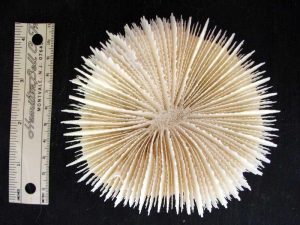
Scolymia lacera is the only solitary coral polyp in the Caribbean that grows over 4″/10cm in diameter.
Scolymia cubensis is usually found in deeper and cryptic habitats where it grows as a single, neatly circular polyp up to three inches in diameter. The surface of S. cubensis is smoother in appearance than the larger S. lacera. The color of S. cubensis is a mostly uniform green, red or brown with very little mottling or patterning and it may or may not fluoresce. Juvenile Scolymia polyps cannot be reliably identified without careful examination of the skeletal features.
Mussa angulosa is a relatively uncommon coral on West Atlantic reefs but it is very easily recognized. Colonies are composed of large fleshy polyps which have a rough textured surface. The polyps are circular with a single mouth or uneven in outline with multiple polyps. The overall colony shape is flat or hemispherical and they are usually found at intermediate depths. Colors are usually a muted grey or brown with hints of green and red but they can also be colorfully pink or red. Mussa angulosa closely resembles some of the large polyped species of Lobophyllia from the Pacific Ocean.
Oculiniids
Oculina is a group of stony corals occurring in seas throughout the world. The family Oculiniidae also includes the more familiar Galaxea corals which are regularly available to aquarists. Oculina species are mostly non-photosynthetic with certain species being facultative heterotrophs meaning that they may or may not occur with zooxanthellae and they may experience seasonal fluctuations of zooxanthellae densities. Many species of Oculina are commonly found associated with deed sea reef formations and at least two species are commonly encountered in shallow water environments of the West Atlantic.

Oculina robusta has a thick, tree-like growth form. The conspicuous polyps are retracted in this photograph.
Oculina robusta is an unusual coral which prefers turbid shallow water environments. O. robusta is only found in Tampa Bay and the western coast of Florida and as a result it is commonly imported on the live rock which is cultured in the area. The species grows very sturdy, tapering branches from an even wider base. The large corallites have protruding rims and they are tightly spaced towards the branch tips and widely spaced towards the base. The color is a uniform dark brown with a surface that appears almost shaggy when the polyps are fully extended.
Unlike O. robusta, O. diffusa has a much more widespread distribution throughout the Caribbean. Oculina diffusa has much thinner branches which are very closely spaced giving the colony a thicket-like appearance. O. diffusa occurs in shallow lagoon and calm reef environments and it is frequently found growing among seagrass or on shipwrecks. The species can be deep brown when it is exposed to sunlight or it can be ghostly white if it is shaded or growing in a cave or overhang. Oculina diffusa colonies do not grow very large because the old skeleton is often dead and covered by encrusting organisms which accelerate the bioerosion of the delicate branching structure.
Caryophillidae
The coral family Caryophyllidae is represented in the West Atlantic Ocean by many small solitary and colonial species, only one true reef-building species and perhaps the first documented case of an introduced stony coral species. Cladocora arbuscula is a small branching, photosynthetic species. The brown to golden brown colonies of C. arbuscula can grow in tight clusters or as loose tangles. Phyllangia American grows usually as a single medium sized polyp. P. Americana is non-photosynthetic, with clear tentacles and a hint of reddish marking around the mouth. Tubastrea coccinea is familiar to most reef keepers as sun coral. This coral is normally found in the Pacific Ocean but beginning in the 1940s, this coral started being sighted on Dutch Caribbean reefs. Sun coral is believed to have been introduced by hitching a ride on the bottoms of shipping boats from the Pacific and it has since spread from the Lesser Antilles to the Texas
Flower Garden Banks.

Top left, Cladocora arbuscula, Photo by Ernesto Weil. Top right, Astrangia solitaria, not a Caryophyllid. Bottom left, Phyllangia americana. Bottom right, the familiar sun coral, Tubastrea coccinea.
Eusmilia fastigiata is the only Caryophyllid in the West Atlantic Ocean which is an important reef-building coral. E. fastigiata colonies form hemispherical mounds of stalked polyps which appear to originate from a central point. The greenish or brown polyps are retracted during the day, revealing prominent septa on the circular to oval corallites. This species is most common in shallow to intermediate reefs which are somewhat protected from strong water movement.
Hydrocorals
Although Hydrocorals are not true corals, no review of Atlantic corals would be complete without at least describing this important group of reef building animals. As the name implies, fire coral has a potent sting that feels like a burning sensation to human skin. The major group of Hydrocorals is fire coral in the genus Millepora. Fire coral has a very dense skeleton covered by brown to golden tissue which is pale at the growing edge or tip. The two most common species are M. alcicornis and M. complanata. Millepora alcicornis is a thin branching species which is found in shallow to intermediate water. The branching pattern tends to remain in a single plane but M. alcicornis also aggressively encrusts the substrate. M. alcicornis is often seen encrusting gorgonian skeletons, sometimes so faithfully that every little vignette of a sea fan remains visible. Millepora complanata grows as a succession of short, sharp blades. M. complanata is a very sturdy species which is common in very shallow reefs where it is exposed to strong wave action.

It is much less common for Millepora alcicornis to branch on its own than to encrust an exisitng structure such as the remains of this sea fan skeleton.

Millepora complanata forms very dense aggregations especially in shallow water where it is exposed to strong surge.
Addendum
Solenastrea is a genus which was mistakenly omitted from the overview of West Atlantic Faviids in the previous article. The genus includes two species and it is characterized by intermediate sized polyps which are extended throughout the day, giving the surface a fuzzy appearance. S. bournoni is common in a wide range of habitats. The colonies are massive to hemispherical, with a golden brown and somewhat irregular surface. The corallite rims are irregularly spaced and noticeably exert from the surface. S. hyades also grows in a wide range of environments but it is particularly abundant in shallow turbid environments which are subject to a high degree of sedimentation. This species grows colonies which are hemispherical and columnar in shape with conspicuous bulges and finger-like projections eventually developing on the top side of colonies. The polyps are dark and widely spaced with pale to white tissue in between them, giving colonies a spotted appearance when the polyps are retracted.

The light colored tissue and dark colored polyps of Solenastrea hyades give the surface a spotted appearance, especially when the polyps are retracted like in this specimen.
Reference
- Humann, Paul and Ned DeLoach. 2002. Reef Coral Identification. New World Publications Inc. Jacksonville, Florida.
- Wood, Elizabeth. 1983. Corals of the World. T.F.H.






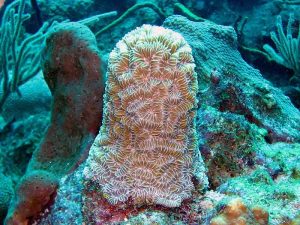


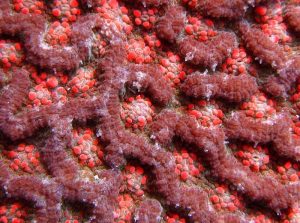







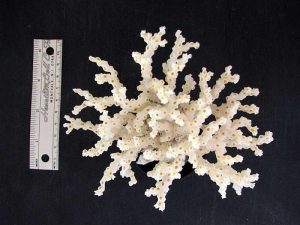





0 Comments